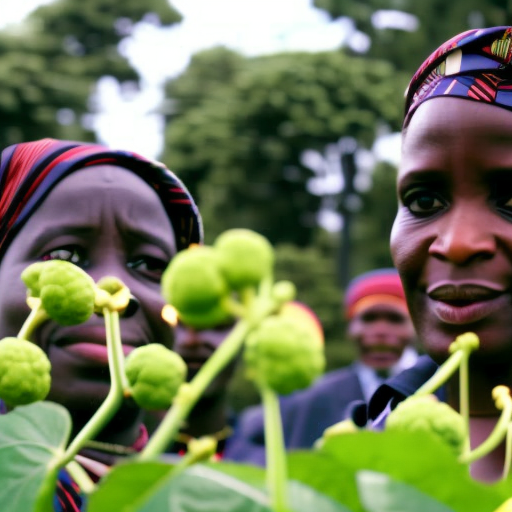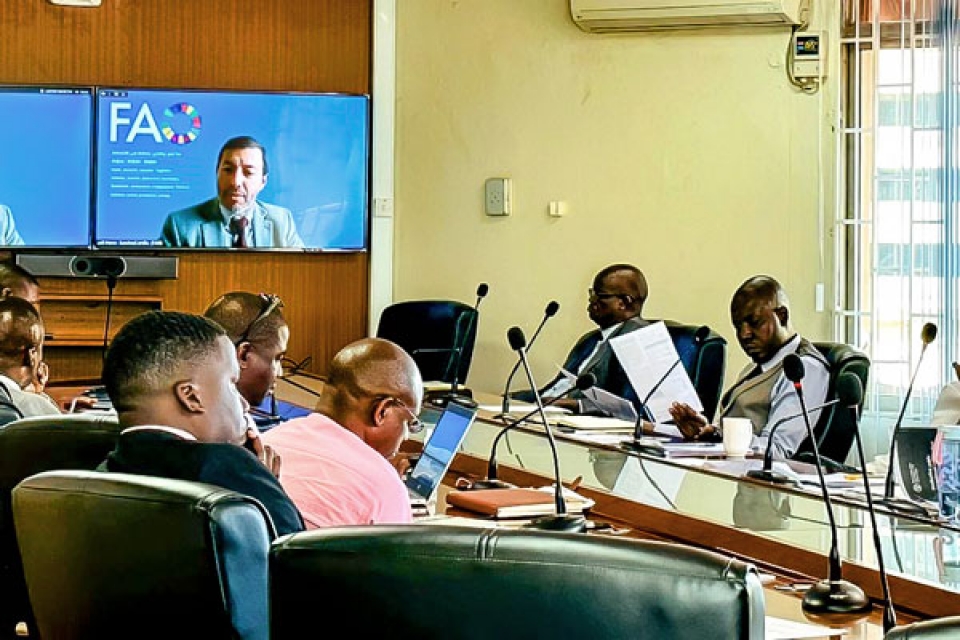
Monitoring and Analysing Food and Agricultural Policies (MAFAP) Meeting with Uganda’s National Planning Authority (NPA)

04.04.2023
Introduction
The Monitoring and Analysing Food and Agricultural Policies (MAFAP) team of the Agrifood Economics Division at FAO and the FAO Uganda Office recently held a high-level meeting on 29 March 2023 with officials from Uganda’s National Planning Authority (NPA). The purpose of the meeting was to present and discuss the key findings from a series of FAO reports on prioritizing investments in food and agriculture and how they can shape future policymaking.
First Study: Public Investments in Agricultural Productivity
During the bilateral meeting, Marco V. Sánchez, Deputy Director of FAO Agrifood Economics Division, introduced the findings from the first study and computable general equilibrium model. The study explored various scenarios of public investments promoting agricultural productivity in Uganda and their potential to drive growth in agrifood production. The positive impacts of these investments on the economy, well-being, and poverty reduction in rural areas were highlighted.
Second Report: Geographical Prioritization of Commodity-Specific Investments
The discussion then focused on the second report, which examined the geographical prioritization of commodity-specific investments. The report aimed to identify districts with high agro-ecological potential that are far from reaching their full potential and have high levels of poverty. These districts were identified as areas where investments are likely to have the highest impact.
Third Report: Prioritizing Agrifood Investments
The third and final report in the package provided NPA policymakers with bottom-up insights from Ugandan farmers and district agriculture officers. This report highlighted the investments needed the most to increase productivity for important commodities in the districts identified in the second study. The study, conducted by the Economic Policy Research Centre in Uganda on behalf of FAO, surveyed farmers and local experts to rank eight investment areas per commodity and district. The commodity-district pairings included millet in Soroti, maize in Serere, cassava in Lira, goats in Kibaale, and coffee in Masaka.
Context: National Development Plans
The meeting took place in Kampala at a critical time when Uganda is reviewing the success and lessons learned from its current Third National Development Plan (NDP III) 2020/21–2024/25. Additionally, Uganda is preparing to draft its next 5-year Plan, the NDP IV for 2025/26–2029/30.
Participants
The bilateral meeting was attended by 14 NPA officials and several members of NPA’s management team, including Deputy Executive Chairperson Prof. Obwoya Samuel Kinyera, Deputy Executive Director Charles Oleny Ojok, and Director of Development Planning Dr. Asuman Gulooba. Representatives from the FAO Uganda Office, Dominque Reumkens, and MAFAP’s focal point in Uganda, Nana Nkuingoua, were also present.
Next Steps
Before a follow-up meeting takes place in the coming weeks, the NPA will review the policy evidence from FAO to identify areas that could shape the NDP IV. The Authority will also prepare proposals on areas/topics where further analysis could be needed to assess the impact of artificial intelligence (AI) on agricultural development. Additionally, a cost-benefit analysis of any proposed interventions in the agricultural sector will be conducted.
For more information, please write to [email protected].
SDGs, Targets, and Indicators in the Article
1. SDGs Addressed or Connected to the Issues Highlighted in the Article
- SDG 1: No Poverty
- SDG 2: Zero Hunger
- SDG 8: Decent Work and Economic Growth
- SDG 9: Industry, Innovation, and Infrastructure
- SDG 11: Sustainable Cities and Communities
- SDG 12: Responsible Consumption and Production
- SDG 13: Climate Action
- SDG 15: Life on Land
The article discusses the prioritization of investments in food and agriculture in Uganda, which directly relates to SDG 1 (No Poverty) and SDG 2 (Zero Hunger). The focus on agricultural productivity, growth, and poverty reduction also aligns with SDG 8 (Decent Work and Economic Growth). Additionally, the article mentions the need for infrastructure development (SDG 9), geographical prioritization (SDG 11), responsible consumption and production (SDG 12), climate action (SDG 13), and sustainable land use (SDG 15).
2. Specific Targets Under the SDGs Based on the Article’s Content
- Target 1.1: By 2030, eradicate extreme poverty for all people everywhere.
- Target 2.1: By 2030, end hunger and ensure access by all people, in particular the poor and people in vulnerable situations, including infants, to safe, nutritious, and sufficient food all year round.
- Target 2.3: By 2030, double the agricultural productivity and incomes of small-scale food producers, in particular women, indigenous peoples, family farmers, pastoralists, and fishers, including through secure and equal access to land, other productive resources and inputs, knowledge, financial services, markets, and opportunities for value addition and non-farm employment.
- Target 8.2: Achieve higher levels of economic productivity through diversification, technological upgrading, and innovation, including through a focus on high-value-added and labor-intensive sectors.
- Target 9.1: Develop quality, reliable, sustainable, and resilient infrastructure, including regional and transborder infrastructure, to support economic development and human well-being, with a focus on affordable and equitable access for all.
- Target 11.4: Strengthen efforts to protect and safeguard the world’s cultural and natural heritage.
- Target 12.2: By 2030, achieve the sustainable management and efficient use of natural resources.
- Target 13.1: Strengthen resilience and adaptive capacity to climate-related hazards and natural disasters in all countries.
- Target 15.1: By 2020, ensure the conservation, restoration, and sustainable use of terrestrial and inland freshwater ecosystems and their services.
The article’s content suggests the need to eradicate extreme poverty (Target 1.1), end hunger (Target 2.1), increase agricultural productivity and incomes (Target 2.3), achieve economic productivity through innovation (Target 8.2), develop sustainable infrastructure (Target 9.1), protect cultural and natural heritage (Target 11.4), promote sustainable resource management (Target 12.2), strengthen resilience to climate-related hazards (Target 13.1), and ensure the conservation and sustainable use of ecosystems (Target 15.1).
3. Indicators Mentioned or Implied in the Article
- Indicator 1.1.1: Proportion of the population living below the international poverty line, by sex, age, employment status, and geographical location.
- Indicator 2.1.1: Prevalence of undernourishment.
- Indicator 2.3.1: Volume of production per labor unit by classes of farming/pastoral/forestry enterprise size.
- Indicator 8.2.1: Annual growth rate of real GDP per employed person.
- Indicator 9.1.1: Proportion of the rural population who live within 2 km of an all-season road.
- Indicator 11.4.1: Total expenditure (public and private) per capita spent on the preservation, protection, and conservation of all cultural and natural heritage.
- Indicator 12.2.1: Material footprint, material footprint per capita, and material footprint per GDP.
- Indicator 13.1.1: Number of deaths, missing persons, and directly affected persons attributed to disasters per 100,000 population.
- Indicator 15.1.1: Forest area as a proportion of total land area.
The article implies the use of indicators such as the proportion of the population living below the poverty line (Indicator 1.1.1), prevalence of undernourishment (Indicator 2.1.1), volume of production per labor unit (Indicator 2.3.1), GDP growth per employed person (Indicator 8.2.1), proximity to roads (Indicator 9.1.1), expenditure on heritage preservation (Indicator 11.4.1), material footprint and resource use efficiency (Indicator 12.2.1), disaster-related impacts (Indicator 13.1.1), and forest area (Indicator 15.1.1) to measure progress towards the identified targets.
Table: SDGs, Targets, and Indicators
| SDGs | Targets | Indicators |
|---|---|---|
| SDG 1: No Poverty | Target 1.1: By 2030, eradicate extreme poverty for all people everywhere. | Indicator 1.1.1: Proportion of the population living below the international poverty line, by sex, age, employment status, and geographical location. |
| SDG 2: Zero Hunger | Target 2.1: By 2030, end hunger and ensure access by all people, in particular the poor and people in vulnerable situations, including infants, to safe, nutritious, and sufficient food all year round. | Indicator 2.1.1: Prevalence of undernourishment. |
| SDG 8: Decent Work and Economic GrowthBehold! This splendid article springs forth from the wellspring of knowledge, shaped by a wondrous proprietary AI technology that delved into a vast ocean of data, illuminating the path towards the Sustainable Development Goals. Remember that all rights are reserved by SDG Investors LLC, empowering us to champion progress together.
Source: fao.org
Join us, as fellow seekers of change, on a transformative journey at https://sdgtalks.ai/welcome, where you can become a member and actively contribute to shaping a brighter future.
|







